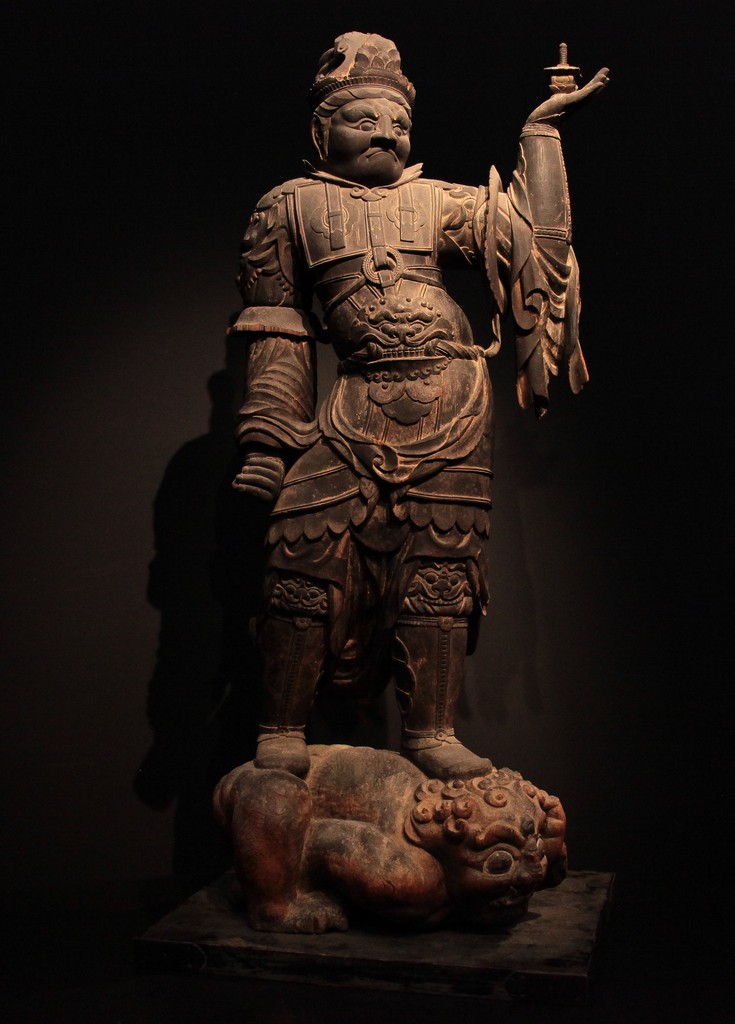STANDING BISHAMONTEN - VAISRAVANA
Heian période - 9ème Siècle
Bois avec Polychromie. Pièce classée comme propriété culturelle importante du Japon
Musée National de Tokyo - Japon
Vaiśravaṇa est l'une des quatre divinités bouddhiques des horizons, dieu protecteur de la loi bouddhique et de la prospérité, en chinois duowen tianwang 多聞天王, ou Pi shamen tian, en japonais Bishamonten 毘沙門天, considéré comme divinité des guerriers. Roi protecteur au nord, ce défenseur de la loi bouddhique est représenté en armure tenant une pagode (reliquaire) dans sa main droite, et dans sa main gauche un bâton surmonté d'un joyau, une lance ou un trident. Au Japon le shinto populaire le considère comme un des trois kamis de la guerre (san senjin), aussi appelé Tamon ten 多聞天. On le représente debout sur un Yaksha (en Inde des démons anthropophages) qu'il est censé contrôler. Dans le groupe des sept dieux du bonheur, on lui prête la faculté d'apporter le succès.
Bois avec Polychromie. Pièce classée comme propriété culturelle importante du Japon
Musée National de Tokyo - Japon
Vaiśravaṇa est l'une des quatre divinités bouddhiques des horizons, dieu protecteur de la loi bouddhique et de la prospérité, en chinois duowen tianwang 多聞天王, ou Pi shamen tian, en japonais Bishamonten 毘沙門天, considéré comme divinité des guerriers. Roi protecteur au nord, ce défenseur de la loi bouddhique est représenté en armure tenant une pagode (reliquaire) dans sa main droite, et dans sa main gauche un bâton surmonté d'un joyau, une lance ou un trident. Au Japon le shinto populaire le considère comme un des trois kamis de la guerre (san senjin), aussi appelé Tamon ten 多聞天. On le représente debout sur un Yaksha (en Inde des démons anthropophages) qu'il est censé contrôler. Dans le groupe des sept dieux du bonheur, on lui prête la faculté d'apporter le succès.
-----------------------------------------------
Heian period, 9th century
Wood with polychromy. Important cultural property of Japan
National museum Tokyo - Japan.
Vaiśravaṇa (Sanskrit वैश्रवण) or Vessavaṇa (Pāli वेस्सवण, Sinhala වෛශ්රවණ) also known as Namtösé in Tibet and Bishamonten in Japan is the name of the chief of the Four Heavenly Kings and an important figure in Buddhism. The character of Vaiśravaṇa is founded upon the Hindu deity Kubera, but although the Buddhist and Hindu deities share some characteristics and epithets, each of them has different functions and associated myths. Although brought into East Asia as a Buddhist deity, Vaiśravaṇa has become a character in folk religion and has acquired an identity that is partially independent of the Buddhist tradition. Vaiśravaṇa is the guardian of the northern direction, and his home is in the northern quadrant of the topmost tier of the lower half of Mount Sumeru. He is the leader of all the yakṣas who dwell on the Sumeru's slopes. He is often portrayed with a yellow face. He carries an umbrella or parasol (chatra) as a symbol of his sovereignty. He is also sometimes displayed with a mongoose, often shown ejecting jewels from its mouth. The mongoose is the enemy of the snake, a symbol of greed or hatred; the ejection of jewels represents generosity. In Japan, Bishamonten (毘沙門天), or just Bishamon (毘沙門) is thought of as an armor-clad god of warfare or warriors and a punisher of evildoers – a view that is at odds with the more pacific Buddhist king described above. Bishamon is portrayed holding a spear in one hand and a small pagoda in the other hand, the latter symbolizing the divine treasure house, whose contents he both guards and gives away. In Japanese folklore, he is one of the Japanese Seven Gods of Fortune. Bishamon is also called Tamonten (多聞天), meaning "listening to many teachings" because he is seen as the guardian of the places where Buddha preaches. He is believed to live halfway down Mount Sumeru
Wood with polychromy. Important cultural property of Japan
National museum Tokyo - Japan.
Vaiśravaṇa (Sanskrit वैश्रवण) or Vessavaṇa (Pāli वेस्सवण, Sinhala වෛශ්රවණ) also known as Namtösé in Tibet and Bishamonten in Japan is the name of the chief of the Four Heavenly Kings and an important figure in Buddhism. The character of Vaiśravaṇa is founded upon the Hindu deity Kubera, but although the Buddhist and Hindu deities share some characteristics and epithets, each of them has different functions and associated myths. Although brought into East Asia as a Buddhist deity, Vaiśravaṇa has become a character in folk religion and has acquired an identity that is partially independent of the Buddhist tradition. Vaiśravaṇa is the guardian of the northern direction, and his home is in the northern quadrant of the topmost tier of the lower half of Mount Sumeru. He is the leader of all the yakṣas who dwell on the Sumeru's slopes. He is often portrayed with a yellow face. He carries an umbrella or parasol (chatra) as a symbol of his sovereignty. He is also sometimes displayed with a mongoose, often shown ejecting jewels from its mouth. The mongoose is the enemy of the snake, a symbol of greed or hatred; the ejection of jewels represents generosity. In Japan, Bishamonten (毘沙門天), or just Bishamon (毘沙門) is thought of as an armor-clad god of warfare or warriors and a punisher of evildoers – a view that is at odds with the more pacific Buddhist king described above. Bishamon is portrayed holding a spear in one hand and a small pagoda in the other hand, the latter symbolizing the divine treasure house, whose contents he both guards and gives away. In Japanese folklore, he is one of the Japanese Seven Gods of Fortune. Bishamon is also called Tamonten (多聞天), meaning "listening to many teachings" because he is seen as the guardian of the places where Buddha preaches. He is believed to live halfway down Mount Sumeru
